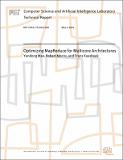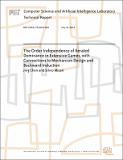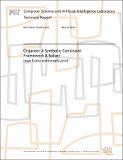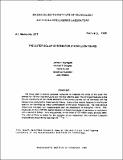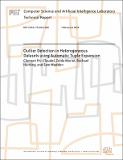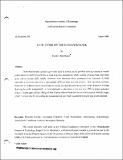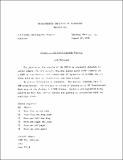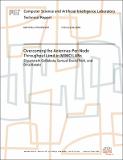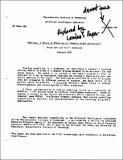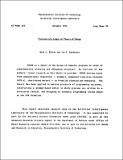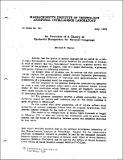Browsing Computer Science and Artificial Intelligence Lab (CSAIL) by Title
Now showing items 2414-2433 of 3804
-
Optimizing MapReduce for Multicore Architectures
(2010-05-02)MapReduce is a programming model for data-parallel programs originally intended for data centers. MapReduce simplifies parallel programming, hiding synchronization and task management. These properties make it a promising ... -
Optimizing Synchronous Systems
(1982-03)The complexity of integrated-circuit chips produced today makes it feasible to build inexpensive, special-purpose subsystems that rapidly solve sophisticated problems on behalf of a general-purpose host computer. This paper ... -
The Order Independence of Iterated Dominance in Extensive Games, with Connections to Mechanism Design and Backward Induction
(2012-07-31)Shimoji and Watson (1998) prove that a strategy of an extensive game is rationalizable in the sense of Pearce if and only if it survives the maximal elimination of conditionally dominated strategies. Briefly, this process ... -
Organic Indoor Location Discovery
(2008-12-30)We describe an indoor, room-level location discovery method based on spatial variations in "wifi signatures," i.e., MAC addresses and signal strengths of existing wireless access points. The principal novelty of our system ... -
Organization of Systems with Bussed Interconnections
(1992-03)This thesis explores using busses in communication architectures and control structures. First, we investigate the organization of permutation architectures with bussed interconnections. We explore how to efficiently ... -
Organizing a Global Coordinate System from Local Information on an Amorphous Computer
(1999-08-29)This paper demonstrates that it is possible to generate a reasonably accurate coordinate system on randomly distributed processors, using only local information and local communication. By coordinate systems we imply ... -
Organon: A Symbolic Constraint Framework & Solver
(2013-05-24)Organon is an open source system for expressing and solving complex symbolic constraints between generic entities. Our design avoids restricting the programmer s ability to phrase constraints; Organon acts purely as a ... -
Orienting Silicon Integrated Circuit Chips for Lead Bonding
(1975-01-01)Will computers that see and understand what they see revolutionize industry by automating the part orientation and part inspection processes? There are two obstacles: the expense of computin and our feeble understanding ... -
Orphan Detection in the Argus System
(1984-05)In a distributed system, an activity running at one node can request another node to perform some service. This request results in an activity being created at the latter node to perform the requested service. The former ... -
The Outer Solar System for 210 Million Years
(1986-02-01)We used a special purpose computer to integrate the orbits of the outer five planets for 100 Myr into the future and 100 Myr into the past. The strongest features in the Fourier transforms of the orbital elements of ... -
Outlier Detection in Heterogeneous Datasets using Automatic Tuple Expansion
(2016-02-08)Rapidly developing areas of information technology are generating massive amounts of data. Human errors, sensor failures, and other unforeseen circumstances unfortunately tend to undermine the quality and consistency of ... -
An Outlook on Truth Maintenance
(1980-08-01)Truth maintenance systems have been used in several recent problem solving systems to record justifications for deduced assertions, to track down the assumptions which underlie contradictions when they arise, and to ... -
Output to the PDP-6 Calcomp Plotter
(1966-08-01)The plotter on the console of the PDP-6 is currently attached to device number 774, and accepts stepping pulses given under control of a CONO to that device. Its normal mode of operation is to CONO the desired bits on, ... -
Overcoming the Antennas-Per-Node Throughput Limit in MIMO LANs
(2009-02-18)Today, the number of concurrent packets in a MIMO LAN is limited by the number of antennas on the AP. This paper shows how to overcome this limit. It presents a new design where multiple client-AP pairs can communicate ... -
Overlays: A Theory of Modelling for Computer Aided Instruction
(1977-02-01)Overlay modelling is a technique for describing a student's problem solving skills in terms of modular program designed to be an expert for the given domain. The model is an overlay on the expert program in that it consists ... -
Overview of a Linguistic Theory of Design
(1977-02-01)SPADE is a theory of the design of computer programs in terms of complementary planning and debugging processes. An overview of the authors' recent research on this theory is provided. SPADE borrows tools from ... -
Overview of a Linguistic Theory of Design
(1977-02-01)The SPADE theory uses linguistic formalisms to model the program planning and debugging processes. The theory has been applied to constructing a grammar-based editor in which programs are written in a structured ... -
An Overview of a Theory of Syntactic Recognition for Natural Language
(1979-07-01)Assume that the syntax of natural language can be parsed by a left-to-right deterministic mechanism without facilities for parallelism or backup. It will be shown that this "determinism" hypothesis, explored within the ... -
An Overview of MOOS-IvP and a Brief Users Guide to the IvP Helm Autonomy Software
(2009-06-18)This document describes the IvP Helm - an Open Source behavior-based autonomy application for unmanned vehicles. IvP is short for interval programming - a technique for representing and solving multi-objective optimizations ... -
An Overview of MOOS-IvP and a Users Guide to the IvP Helm - Release 4.2.1
(2011-08-03)This document describes the IvP Helm - an Open Source behavior-based autonomy application for unmanned vehicles. IvP is short for interval programming - a technique for representing and solving multi-objective optimizations ...

